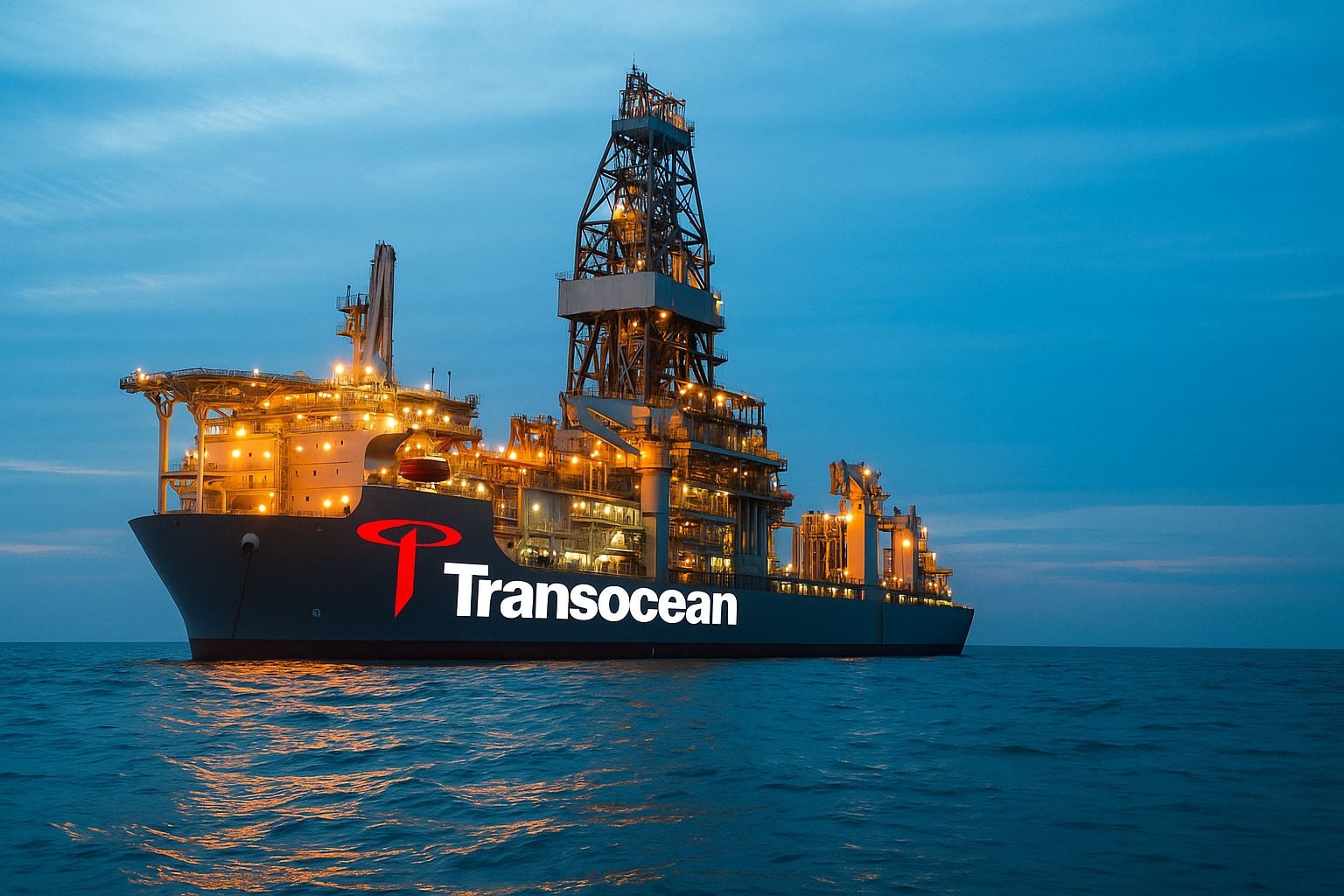- Stock Price & Momentum: Transocean Ltd. (NYSE: RIG) trades around the mid-$3 range, recently near $3.40, after a volatile month. The stock rebounded ~5–6% last week, climbing off late-September lows around $3.14 [1]. It has risen for four straight sessions into Oct. 22 [2], indicating positive near-term momentum.
- Insider Confidence: A major insider, board member Frederik W. Mohn (via his firm Perestroika Ltd.), bought 4 million shares for ~$12.2 million during Transocean’s recent equity offering [3]. This raised Mohn’s holdings above 10% (≈95 million shares) and was “highly unusual and shows strong conviction in RIG stock from a major investor,” according to analysts [4]. The bold insider buy signaled insiders see significant value at current prices, boosting market confidence.
- New Contracts & Backlog: Transocean secured $243 million in new drilling contracts for two ultra-deepwater rigs, underscoring strong demand for offshore projects [5]. These awards lifted the company’s order backlog to about $7.2 billion (as of Q2 2025) [6], adding to a growing pipeline of future revenue. The deals “signal stronger demand for offshore drilling” at healthy dayrates, a positive sign for Transocean’s long-term recovery [7].
- Debt Reduction Moves: To tackle its hefty debt, Transocean raised $381 million in late September via a public stock offering of 125 million shares at $3.05 (about 13% dilution) [8]. Proceeds are earmarked to pay down high-interest bonds (notably 8% notes due 2027). In mid-October, the company also issued $500 million in new senior notes and even upsized a cash tender offer – doubling it from $50M to $100M – to retire portions of other long-term notes [9]. These proactive refinancing steps aim to cut interest costs and strengthen the balance sheet.
- Fleet Overhaul: Transocean is streamlining its fleet by divesting five older “stacked” (idle) rigs. It sold or slated these aging rigs for demolition, which will incur a one-time ~$1.9 billion non-cash impairment charge in Q3 2025 [10]. While this write-down will deepen the upcoming quarterly loss, it “right-sizes” the fleet by removing low-spec assets, allowing focus on modern high-spec drillships for better utilization going forward [11].
- Analyst Outlook: Wall Street’s 12-month consensus price target for RIG is around $4.20–$4.30 per share – roughly 25–30% above current levels [12]. Individual targets range from about $2.80 (most bearish) to $5.50 (bullish) [13]. Notably, Bank of America recently raised its target to $3 (from $2.50) while maintaining an “Underperform” rating [14]. The overall analyst consensus is Hold, reflecting Transocean’s heavy debt and mixed near-term outlook, even as offshore fundamentals improve.
- Oil Market Context: Crude oil prices in late October 2025 remain relatively soft (around $56 for WTI and $60 for Brent) compared to last year [15]. However, the offshore drilling segment is rebounding as technology drives costs down – many new deepwater projects can break even at just $20–$35 per barrel [16]. This trend is shifting investment back offshore, providing a tailwind for contractors like Transocean amid a broader oil sector revival.
Insider Buy and New Deals Spark a Mid-October Rally
Transocean’s stock staged a modest comeback in mid-October after a slew of positive developments reignited investor interest. On October 16, RIG shares jumped over 5% in a single day as the market cheered news of insider buying, fresh contracts, and aggressive debt refinancing [17]. The catalyst was the disclosure that Frederik Wilhelm Mohn – a Transocean director and member of a prominent Norwegian oil family – had scooped up 4 million shares in the late-September equity offering, investing roughly $12.2 million [18]. Such a sizable insider purchase is “highly unusual and shows strong conviction in RIG stock from a major investor,” analysts noted [19]. This bold vote of confidence from an insider with deep industry ties helped soothe dilution fears and signaled to other investors that those closest to the company see significant value at current prices.
Almost simultaneously, Transocean announced it won $243 million in new contracts for two of its ultra-deepwater drillships [20]. These multi-year awards not only boost revenue backlog but also “signal stronger demand for offshore drilling” going forward [21]. Securing new work at robust dayrates reinforces the view that oil producers are investing in major offshore projects again – a key factor for Transocean’s long-term recovery. The company’s backlog had already climbed to $7.2 billion by mid-2025 [22], and the fresh contracts add further to that pipeline of future revenue. In short, Transocean’s insider bet and operational wins in October provided a one-two punch of confidence: insiders are doubling down, and customers are lining up for its rigs.
Another contributor to the stock’s strength was Transocean’s proactive attack on its debt load. In mid-October, alongside the other news, the company priced $500 million in new secured notes (due 2032) and launched a cash tender offer to retire some nearer-term bonds [23]. These moves followed closely on the heels of the late-September equity raise and demonstrated management’s commitment to shoring up the balance sheet. By boosting liquidity and pushing out debt maturities, Transocean aims to ensure it can weather any market volatility until higher-margin contracts translate into stronger cash flows. “We also continue to improve our balance sheet and are on track to reduce our debt by over $700 million this year,” CEO Keelan Adamson said back in August [24] – and the recent actions back up that resolve.
The flurry of insider buying, contract wins, and refinancing news in October lifted Transocean’s stock well off its lows. By October 15, just before these announcements, RIG had already drifted up to around $3.31 [25], rebounding from late-September lows near $3.14. The mid-October rally pushed shares into the mid-$3s, indicating that momentum had swung positive – at least for now – albeit on modest trading volumes [26].
Wall Street took note of the developments. Bank of America, for instance, cited Transocean’s strategic maneuvers in raising its price objective on RIG to $3 (from $2.50) while maintaining an underperform rating [27]. BofA’s cautious stance suggests even skeptics acknowledge Transocean’s improving outlook, though they remain guarded on how much near-term upside is warranted. Overall, the mid-October news cycle gave Transocean a palpable boost in sentiment: the stock’s steep slide reversed into a bounce, and analysts began recalibrating their models to account for the company’s bold steps.
Debt Reduction After a Dilution Shock
Just a few weeks prior, Transocean’s stock had been reeling from a dilution-driven selloff. On September 25, the company surprised the market by upsizing a public equity offering to 125 million new shares at $3.05 each, raising roughly $381 million [28]. This capital raise – equivalent to about 13% of the pre-offer share count (or ~15% if all overallotment options are exercised) – was aimed squarely at chipping away its hefty debt load [29]. Specifically, proceeds were slated to redeem a portion of Transocean’s 8.00% senior notes due 2027, with any extra cash for general corporate purposes [30]. By paying down these high-interest bonds, Transocean can save tens of millions in annual interest expense, easing a notable financial burden [31].
The immediate market reaction to the share sale was brutal. RIG shares plunged as much as 13–17% in pre-market trading when the pricing hit the wires [32]. The offering came at an 11% discount to the prior day’s close, and the dilution alarmed investors. The stock, which had traded around $3.60 just before, sank into the low-$3s – bottoming near $3.14 on the news [33]. By the next day (Sept. 26), shares stabilized around $3.16 [34]. Notably, despite the late-month tumble, Transocean’s stock still finished the full month of September up ~5% overall [35]. This resilience was due in part to the aforementioned insider, Mohn, stepping in to buy a big chunk of the new shares [36]. His participation signaled to other investors that the dilution might ultimately be a long-term positive if it fixes the balance sheet [37]. In classic form, Transocean chose short-term pain (EPS dilution and a stock drop) in exchange for long-term gain (a stronger capital structure) – a strategy mirrored by other offshore drilling peers who also issued equity this year to deleverage [38].
Crucially, Transocean’s decision to raise equity came from a position of improving fundamentals rather than last-ditch desperation. The company’s Q2 2025 results showed $988 million in revenue – beating analyst forecasts – and essentially break-even adjusted earnings [39]. It also marked a turning point of slightly positive free cash flow in 2025 [40]. Transocean’s contract backlog stood at $7.2 billion by mid-year with healthier rig utilization, thanks to surging demand for ultra-deepwater projects [41]. With this backdrop, CEO Adamson was keen to pay down debt while the offshore cycle gathers steam, stating the goal to reduce debt by over $700 million for the year [42]. In late August, management took another tough-but-necessary step: they moved to divest five aging rigs that had been stacked (idle), essentially deciding to scrap them. By September, industry reports confirmed four idle rigs were sold for demolition [43]. This showed Transocean’s commitment to pruning lower-spec assets from its fleet. The decision carries a cost – an estimated ~$1.9 billion impairment charge will hit the third quarter results due out next week [44] – but it’s a non-cash hit aimed at cleaning up the fleet for better utilization going forward. By culling older rigs and raising fresh cash to retire debt, Transocean is attempting a high-stakes balance sheet repair that could set it up for a more sustainable future if executed well [45].
Today, after all these moves, Transocean’s total debt remains substantial (roughly $6.5 billion in total debt outstanding) [46]. The company has little margin for error, and its upcoming Q3 earnings report (scheduled for Oct. 29, 2025) will be closely watched for updates on how well management is navigating this transition [47]. The large impairment will likely put Transocean in the red for the quarter, but investors will focus on operational metrics (revenues, cash flow, rig utilization) and any guidance for 2026. The hope is that the short-term pain of dilution and write-downs will translate into long-term gain via lower debt and a leaner, more efficient fleet. As one market observer noted, the stock’s volatility in October – down ~8% one week, then up 10% the next – reflects traders “digesting a flood of news and trying to gauge if this is the start of a genuine comeback or just a short-term bounce.” [48] For now, Transocean has earned a tentative nod from investors with its balance sheet moves, but execution in the coming quarters remains key.
Short-Term Trading Trends and Technical Outlook
After its late-September tumble and subsequent rebound, RIG’s stock has been charting a choppy but upward path in recent weeks. The shares have posted gains in 6 of the last 10 trading days and rose about 3.3% on October 22 alone, closing around $3.42 [49]. In fact, the stock has climbed for four straight days through Oct. 22 [50] – a short-term winning streak that hints at building positive momentum. Trading volume spiked higher on the latest up-day, a bullish technical sign as rising volume alongside price gains suggests firming demand [51] [52].
From a technical analysis standpoint, Transocean’s chart is showing mostly constructive signals. The stock lies in the middle of a rising trend channel in the short term, and continued upside within this trend is indicated barring any new setbacks [53]. Key moving averages have turned upward, and momentum indicators like MACD are flashing bullish [54]. There is nearby chart support around the $3.28–$3.31 zone – roughly the area of recent consolidation and high volume trading [55] [56]. This suggests buyers have been stepping in at those levels. On the upside, initial resistance appears in the mid-$3 range, with sellers evident around ~$3.43–$3.50 [57] [58]. A push above the mid-$3s could open the door for a re-test of the next resistance around $3.55 or higher, while a drop below ~$3.30 might signal a loss of near-term momentum.
Notably, some trading algorithms have turned more optimistic on RIG. One technical forecast expects the stock could rise roughly +14% over the next three months, projecting a potential trading range between about $3.58 and $4.32 in that timeframe [59]. The stock’s short-term trend was recently upgraded from “Hold” to a “Buy” by one quantitative model, citing the confluence of positive signals and the attractive risk/reward at current levels [60]. Of course, such projections are probabilistic – and volatility remains medium-high (RIG’s daily swings have averaged ~4–5% recently [61]). Traders are also wary of the looming earnings release on Oct. 29; implied volatility suggests the stock could move ±5% or more immediately after results [62]. In summary, in the near term Transocean’s technical picture looks encouraging, with a gentle uptrend and defined support, but the stock is still susceptible to news-driven swings around its upcoming earnings and oil market fluctuations.
Analysts’ Forecasts and Long-Term Investment Outlook
Even after the recent bounce, Transocean’s stock remains well below its past highs, suggesting room for potential upside if the offshore recovery continues. At ~$3.30–$3.40 per share, RIG is trading at only about 70% of its 52-week high (~$4.74) and a tiny fraction of its levels from the last oil boom [63]. Wall Street analysts, on average, expect the stock to climb from here. The consensus 12-month price target sits around $4.20–$4.30, which implies roughly a 25–30% gain from current prices [64]. The most bullish analysts see RIG rallying into the mid-$5s (above this year’s peak), while the most pessimistic have targets in the high-$2s (below today’s price) [65]. According to MarketBeat data, among 10 analysts tracked, the average rating on Transocean is essentially Hold – but interestingly with that ~$4.25 mean price objective, even the “neutral” consensus view carries significant upside [66]. Similarly, other surveys (e.g. FactSet) show a mean target in the high-$3s with a few Buy/Overweight ratings in the mix [67]. This points to a cautiously optimistic skew in expectations despite officially muted ratings.
Recent commentary from market experts underscores a tone of guarded optimism. “Transocean offers a unique opportunity for investors willing to look beyond today’s oil market malaise,” one analyst wrote, arguing that the combination of insider buying, fleet high-grading, and debt reduction “sets a compelling foundation for stronger EPS growth — especially in a rising oil price environment.” [68] The stock is undeniably cheap by certain metrics – it currently trades at an extremely low price-to-book ratio of around 0.3x, a steep discount to the broader energy sector’s ~4.5x [69]. This reflects the lingering concerns over Transocean (large debt, recent dilution, still-recovering rig demand), but it also highlights the value proposition if the company’s assets and earnings power normalize. In plain terms, many observers see RIG as undervalued relative to its asset base and turnaround potential, provided that the offshore drilling cycle continues to improve.
Still, risks abound and temper the bull case. Bank of America’s recent target boost to $3 was accompanied by an Underperform rating [70] – effectively a signal that BofA expects Transocean to lag the broader market even though it acknowledges the company’s strides. Such cautious stances hinge on Transocean’s high leverage and the execution risk in delivering on its debt-cutting promises [71]. Despite the influx of cash from equity and notes, Transocean will still carry billions in debt and faces significant annual interest and amortization obligations. S&P Global recently revised Transocean’s credit outlook to “stable” from “negative” after the refinancing efforts, citing improved liquidity [72]. However, the rating agency noted the company remains dependent on favorable market conditions to meet its obligations and projects free cash flow could turn negative again by 2027 if dayrates soften [73] [74]. In the near term, the upcoming Q3 earnings will be a crucial checkpoint – investors will look for reassurance that Transocean can stabilize its operations post-dilution. Any signs of sustained positive cash flow or additional contract wins could strengthen the long-term bull case, while any disappointments or cautious outlook from management might reinforce the bears’ concerns.
Offshore Oil Revival Lifts Transocean’s Prospects
Transocean’s fortunes are inextricably tied to the global oil and gas cycle – and right now, the broader industry backdrop is mixed but showing bright spots for offshore contractors. On one hand, crude oil prices in late 2025 have been underwhelming (WTI crude in the mid-$50s, Brent in the low $60s) amid concerns about sluggish demand and ample supply [75]. These cyclically low prices have kept many energy investors on edge and put a lid on oil-related stock performance broadly. However, dig a bit deeper and a nascent shift emerges that could favor companies like Transocean. After a decade of dominance, U.S. shale production growth is slowing as prime onshore drilling locations are exhausted and capital spending tightens. In contrast, offshore (especially deepwater) projects are gaining momentum as technology lowers their costs and governments support new developments.
Industry experts point out that advances in drilling tech now allow tapping high-pressure, ultra-deepwater reservoirs at much lower cost than a few years ago. “Offshore production will play an increasingly larger role in filling global energy demand,” asserted the CEO of Talos Energy, noting that some new deepwater developments can break even at oil prices as low as $20–$35 per barrel [76]. That is a remarkably low breakeven – far below typical shale oil costs – meaning many offshore projects remain economically viable even with oil around $55–$60. For instance, Talos affirmed that its Gulf of Mexico drilling plans for the second half of 2025 are still attractive at ~$35 oil prices [77]. This resilience is driving a comeback in offshore investment: the U.S. government’s EIA projects Gulf of Mexico oil output will rise by ~100,000 barrels/day in 2025 and keep climbing into 2026 [78], reversing declines from earlier in the decade. Likewise, globally, deepwater exploration is accelerating from Brazil to West Africa to the North Sea. Major oil companies are returning their focus offshore; Chevron, for example, recently projected its own Gulf of Mexico production will jump 50% by 2026 [79]. Such trends bode well for Transocean, which specializes in ultra-deepwater and harsh-environment drilling and operates a fleet of 27 mobile offshore rigs (20 ultra-deepwater drillships/semisubmersibles and 7 harsh-environment floaters) [80]. As one of the world’s largest offshore drilling contractors, Transocean stands to benefit disproportionately when oil majors green-light more deepwater projects.
Investors in RIG will be watching these macro tailwinds closely. If oil prices strengthen later in 2025 or in 2026 – say due to OPEC+ tightening output or a rebound in global demand – it could further improve Transocean’s prospects by spurring additional drilling contracts and boosting cash flows. Conversely, if oil stays soft or dips further, the road to recovery could be slower, putting pressure on Transocean’s liquidity despite the recent fundraising. The company’s strategy is clearly to bet on the offshore cycle: management is taking pain now (dilution, impairments) to clean up the balance sheet so that Transocean can fully capitalize on a multi-year uptrend in deepwater drilling. It’s a plan that entails some short-term sacrifice for potential long-term payoff, essentially wagering that the offshore industry’s tide will continue rising.
Looking Ahead: A High-Risk, High-Reward Bet
As of late October 2025, Transocean finds itself at a pivotal juncture. The stock’s inclusion in various Google News and Discover feeds lately reflects growing public interest in this turnaround story [81]. In many ways, RIG represents a classic high-risk, high-reward scenario: a beaten-down oilfield stock that’s now rallying on fresh catalysts, hoping to ride a sea change in the offshore industry’s fortunes [82]. There is tangible progress – insider confidence, new contracts, improved finances – that wasn’t there a year ago. The company’s bold actions have given it a fighting chance to emerge stronger if the offshore upcycle persists.
Yet Transocean still has much to prove to skeptics. The coming weeks will be critical, starting with the Q3 earnings report on Oct. 29. That release will show the impact of the $1.9B impairment and reveal how core operations are faring amid the flurry of recent deals. Investors will parse any commentary for clues on 2026 outlook, additional contract awards, or further debt-reduction plans. Volatility is likely to remain high around these events – evidenced by the stock’s sharp swings in recent weeks as traders react to each new headline [83]. Patience and a strong stomach may be required for those on board.
In summary, Transocean’s narrative has evolved from distress towards cautious optimism. An insider’s big bet, new business wins, and aggressive balance sheet maneuvers have sparked a revival in its stock from the year’s lows. Analysts see upside, albeit with eyes wide open about the risks. The offshore drilling market’s rebound is providing a much-needed tailwind, but execution and external conditions will determine if RIG’s current rally can transform into a sustained comeback. For now, Transocean is a company on the mend, buoyed by an oil sector revival and internal reforms – and investors are watching closely to see if this embattled driller can finally turn the corner.
Sources: Transocean investor releases; TechStock² (TS2.tech) analysis [84] [85]; Investing.com [86]; MarketBeat [87] [88]; Reuters [89].
References
1. ts2.tech, 2. stockinvest.us, 3. ts2.tech, 4. ts2.tech, 5. ts2.tech, 6. ts2.tech, 7. ts2.tech, 8. ts2.tech, 9. stockstotrade.com, 10. ts2.tech, 11. ts2.tech, 12. ts2.tech, 13. ts2.tech, 14. ts2.tech, 15. ts2.tech, 16. ts2.tech, 17. ts2.tech, 18. ts2.tech, 19. ts2.tech, 20. ts2.tech, 21. ts2.tech, 22. ts2.tech, 23. ts2.tech, 24. ts2.tech, 25. ts2.tech, 26. ts2.tech, 27. ts2.tech, 28. ts2.tech, 29. ts2.tech, 30. ts2.tech, 31. ts2.tech, 32. ts2.tech, 33. ts2.tech, 34. ts2.tech, 35. ts2.tech, 36. ts2.tech, 37. ts2.tech, 38. ts2.tech, 39. ts2.tech, 40. ts2.tech, 41. ts2.tech, 42. ts2.tech, 43. ts2.tech, 44. ts2.tech, 45. ts2.tech, 46. ts2.tech, 47. ts2.tech, 48. ts2.tech, 49. stockinvest.us, 50. stockinvest.us, 51. stockinvest.us, 52. stockinvest.us, 53. stockinvest.us, 54. stockinvest.us, 55. stockinvest.us, 56. stockinvest.us, 57. stockinvest.us, 58. stockinvest.us, 59. stockinvest.us, 60. stockinvest.us, 61. stockinvest.us, 62. stockinvest.us, 63. ts2.tech, 64. ts2.tech, 65. ts2.tech, 66. ts2.tech, 67. ts2.tech, 68. ts2.tech, 69. ts2.tech, 70. ts2.tech, 71. ts2.tech, 72. www.investing.com, 73. www.investing.com, 74. www.investing.com, 75. ts2.tech, 76. ts2.tech, 77. ts2.tech, 78. ts2.tech, 79. ts2.tech, 80. ts2.tech, 81. ts2.tech, 82. ts2.tech, 83. ts2.tech, 84. ts2.tech, 85. ts2.tech, 86. www.investing.com, 87. ts2.tech, 88. ts2.tech, 89. ts2.tech







